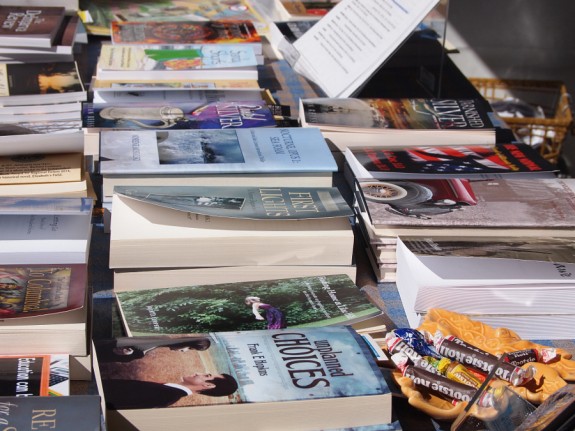When it comes to building a platform, sometimes reading a list of tips just doesn’t cut it. Seeing how real authors find their success can trigger new creative ideas and help you find your footing.
That’s why I’m always curious about what’s really going on out there on the streets. Or in this case, cyberstreets.
There’s nothing wrong with learning from what your fellow authors are doing. Here’s five authors I’ve been keeping tabs on as online platforming role models:
1. Tahereh Mafi
I can’t get over this girl’s sleek and chic author site—Consider Tahereh’s Exhibit A on the difference a top-notch graphic designer can make. But more important than looking nice, this website reflects a distinct Tahereh Mafi brand that is consistent with her natural voice.
Tahereh also has a presence on Facebook, Twitter, Tumblr, Pinterest, and Instagram. And across all of them, she maintains a consistent voice and visuals, and shares about her life and interests beyond promotion her books (check out her Fashion board on Pinterest).
But the savviest move Tahereh’s made? Easily the ebook novelettes she wrote to hold over fans of her Shatter Me series between book releases.
2. Chuck Wendig
Chuck Wendig is the poster child for being true to your voice over trying to please people. His distinct voice, chock-full of off-color metaphors and littered with swear words, is clearly not for everyone. But for fans of his gritty, dark urban fantasies, it’s delightful.
But look past the strange drifting metaphors and swear words, and Wendig’s platform (including Twitter, Flickr and Tumblr) still has the sheen of professionalism. He’s consistent, with posts about his life, the writing process, and contests that celebrate fandom—satisfying readers and writers alike well beyond self-promotion.
And note the “Holy shit, free stories,” tab of his site, where you can get a taste of his writing risk-free before taking the plunge and buying one of his books. Generosity online isn’t just nice, it’s smart business.
3. Rainbow Rowell
I’m not usually a romance fan … but this girl. Like Tahereh Mafi, Rainbow has a nicely designed author site that showcases her distinct personality and voice. She holds a robust presence across Facebook, Twitter, Tumblr, and Goodreads, and is incredibly responsive to fans.
It’s easy to see that Rainbow genuinely loves social media. Her Peter Pan Live! Twitter livechat comments were consistently among my favorites. Never underestimate the power of sharing your interests to connect with readers.
4. Joanna Penn
Is it possible to be everywhere at one? Joanna Penn sure keeps up the appearance of it. She maintains an author website with a blog, as well as accounts on Facebook, Google+, Flickr, LinkedIn, Pinterest, Twitter, and YouTube. She also maintains a second website geared towards the writing community, with its own blog that focuses on advice for other writers.
The best thing about Joanna’s platform is the clear, pinpoint description of the kind of fiction she writes: “Thrillers with a supernatural edge.”
5. Elizabeth Spann Craig
In addition to having an incredible blog for writers, Elizabeth’s writing platform is interesting for how she handles writing under multiple names. Instead of trying to maintain separate platforms for her two author names (how exhausting), she lists her titles under both names together.
Like many others on this list, Elizabeth is generous with her platform, often lending her excellent writers’ blog to guest posts from other authors and frequently sharing other great writer posts she finds on Twitter. She also maintains a presence on Facebook and Google+, and puts out an e-newsletter for readers.
The Bottom Line
So what can we learn from these five awesome platformers? Let’s break down the top takeaways:
- Use multiple channels. All of these authors are using multiple social media channels. That’s not to say you have to be everywhere. Or that you have to start on several channels all at once. Start with what you’re comfortable with, but as you get acclimated on those channels work to slowly expand to at least three or four. More networks means more ways for readers to connect.
- Do what you like. Another commonality here is these authors clearly enjoy their platforms. Don’t create a Twitter account just because it’s trending—choose the channels where you feel comfortable being yourself and have fun. It’ll show, and readers will respond to your enthusiasm.
- Go pro. Don’t underestimate the power of a professional website. If you don’t have the skills to create your own, this is one place where a little investment can really pay off—along with professional photography.
- But if there’s only one thing you take from this post, make it this: There is nothing as good for your platform as knowing and loving your voice. You don’t have to be like anyone else to succeed, just be the best version of your own true voice that you can be. That’s where your greatest unique asset is, and your distinctive, memorable brand. No matter what social network you’re on, it’s tapping into that voice and authenticity that makes readers flock to you.
Never think that just because another author is doing something that you have to do it too. But even if you don’t use the same tactics, it can be helpful to see what others are doing that works.
Do you know other authors with awesome platforms? Share them in the comments!
 By day, Emily Wenstrom, is the editor of short story website wordhaus, author social media coach, and freelance content marketing specialist. By early-early morning, she is E. J. Wenstrom, an award-winning sci-fi and fantasy author whose debut novel Mud was named 2016 Book of the Year by the Florida Writers Association.
By day, Emily Wenstrom, is the editor of short story website wordhaus, author social media coach, and freelance content marketing specialist. By early-early morning, she is E. J. Wenstrom, an award-winning sci-fi and fantasy author whose debut novel Mud was named 2016 Book of the Year by the Florida Writers Association.







